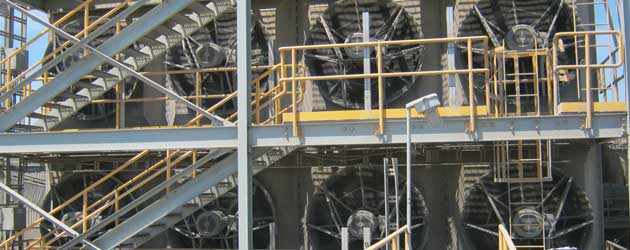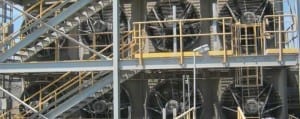Cement Plants, Quarries & Environmental Noise Issues: Part 2

I have received a noise complaint. What should I do?
When addressing a noise complaint, responsiveness and asking plenty of questions is always a good place to start. Are the complaints from more than one neighbour? If so, are they all located in the same direction from the plant? Are the complaints new, or have they been ongoing? Has anything recently changed at the plant, or was there an unusual event that could explain the complaints? If the latter question is the case, then addressing the concern may be more straightforward. However, if the complaints are not so easily explained, then what’s next?
Part 1 of this blog article discussed acoustical modelling during the design of a new or expanded plant, wherein a 3-dimensional model of a plant and the surrounding area are developed, and populated with equipment noise data in order to predict future sound levels in the community. This approach can also be used when the sound levels of an existing plant exceed a noise limit, or in response to a noise complaint (since the loudest equipment at a site is not necessarily the most audible offsite). In this case, the sound levels of individual sources at the site can be measured, the results of which become input to the acoustical model, which can then be used to identify the most significant contributors to the plant-total sound level at a given location (i.e. a complainant), and which are the best candidates for noise control.
In cases where quantitative limits are applicable or adopted, determining which sources require noise control (and how much) toward meeting the limit is more straightforward. However, addressing noise complaints in the absence of quantitative limits (or in cases where limits are met, but further noise reduction is desirable) can be much trickier. How much quieter does the plant/equipment need to be? Unfortunately, there is no straightforward answer to that question; every individual responds differently to noise.
For some, a modest sound level reduction of a few decibels might be satisfactory. For others, as long as they can hear the offending source, it remains an annoyance. A sound level increase or decrease of 10 decibels is perceived as a doubling or halving of the loudness, approximately. Likewise, an increase/decrease of 5 decibels in sound level equates to a perceived change of about 25% in loudness, and an increase/decrease of less than about 3 dB is typically considered imperceptible. Thus, to achieve any perceptible change in sound level at a given point of reception, a minimum of 5 decibels of sound level reduction is advisable, whereas target reductions of 10 decibels or more are likely to achieve clearly audible improvements.
What are some of the challenges and pitfalls of assessing noise from my plant?
So you want to know the sound level of your plant in the surrounding community – perhaps in response to a noise complaint, as a check on compliance with legal obligations, or as a matter of due diligence. What are some of the challenges that might be encountered? Ideally, the result of a sound level measurement conducted at a given point of reception would simply represent the sound level of your plant. However, if there is interference from background sound, such as road traffic or other commercial/industrial noise, then it may not be that simple. Strategies to get around the challenge of interfering sound in the community include:
- Using statistical sound level analytics, such as the “L90” sound level (i.e. the sound level exceeded 90% of the time), which can help to separate steady sound (emitted by the plant) from time-varying sound (such as road traffic)
- Measuring with the plant, or certain suspect items of equipment, turned on and off. The calculated logarithmic difference can be used to isolate the contribution of the plant or equipment alone
- Conducting the measurements during overnight hours (when traffic noise is typically at a minimum)
- Measuring sound levels at intermediate locations, where the sound of the plant is dominant, and applying a distance correction to the location of interest (the intermediate location should be chosen to be at least as far away from the plant as its largest dimension, in plan, in order for this method to be valid)
- Conducting individual source measurements at the plant, and developing an acoustical model to predict the sound levels of the plant at any offsite location of interest.
The last point above is the most complex approach, but provides the considerable added benefit of being able to identify and rank the most significant contributors to offsite sound levels, should noise control be required or desirable. However, this approach involves measuring the sound levels of individual pieces of equipment, which introduces another challenge of interfering sound: how do you isolate the sound emissions of one piece of equipment from another, when conducting measurements in a noisy, heavy industrial environment? An unsophisticated but commonly used method is to turn off all equipment in a given area except that which is being measured – not a terribly practical approach at an operational cement plant.
A far more advanced (and practical) approach is to employ sound intensity measurement instrumentation and methods. Unlike simple measurements of sound pressure (used by the vast majority of industry professionals and acoustical consultants), the sound intensity technique uses a directional probe and sophisticated analyzer to measure both the magnitude and direction of the sound propagating from a source, and can thus accurately isolate the sound emitted by each source from any nearby sources and reject interference from background sound. The use of sound intensity measurements in the field, of which HGC Engineering routinely employs, avoids overestimating sound emissions from individual pieces of equipment, providing a more accurate basis for developing noise control strategies in a cost effective manner.
The use of sound intensity measurements in the field, of which HGC Engineering routinely employs, avoids overestimating sound emissions from individual pieces of equipment, providing a more accurate basis for developing noise control strategies in a cost effective manner. An additional complexity that can crop up in assessing community sound levels, especially in the context of noise complaints, is the unique character of sound that certain equipment can produce, which can be particularly bothersome to the average listener.For instance, the “hum” that a vacuum truck can produce: that pronounced, tonal character can make such equipment more audible (and annoying) than others of a similar loudness, but with a more neutral character. How does one account for this? The noise assessment guidelines of some jurisdictions include penalties that are applied to a measured sound level, to account for the pronounced audibility (and potential for disturbance) of a given source or sound. Naturally, such penalties can have the effect of increasing the ranked contribution of sound from a given source, making it more of a priority candidate for noise control.
What are the typical “big players” in terms of noise emissions at a cement plant, and what kinds of noise control measures are typically employed?
In terms of environmental noise, it is not always the case that the loudest equipment at a site is the most audible offsite. Beyond generating a unique sound character as noted above, the physical location of a source can be a significant factor in offsite audibility. Noise from sources that are elevated (such as kiln exhaust stack outlets) typically carries further into the surrounding area, whereas acoustical shielding afforded by obstructions (both onsite and offsite), such as buildings or quarry walls, can significantly reduce the amount of noise emitted from at-grade sources into the environment. With that in mind, the dominant sources at a cement plant, with regard to environmental noise, are often one or more of the following:
- Crushers
- Rock falling from conveyors onto primary surge piles
- Kiln shell cooling fans
- Kiln and mill exhaust stacks
- Clinker cooler heat exchanger fans
- Vacuum Trucks
- Rail noise (locomotives and/or impulse sounds – “bangs!” – from rail car shunting)
- Procure quieter equipment;
- Administratively limit operation of equipment, or;
- Make existing equipment quieter by applying noise control measures.
Case Study: Essroc Cement Plant, Picton, Ontario
The procurement of quieter equipment can be highly effective, such as in the case of “low noise” replacement fans (which may be part of an exhaust system, heat exchanger, etc.) – Click here to read the the brief case study on a clinker cooler heat exchanger that was equipped with low noise fans to successfully address concerns from a community across the bay from the Essroc cement plant in Picton, Ontario, Canada. 
Administratively limiting the operation of certain sources can be effective for equipment or activities for which physical noise controls would be problematic (and quieter equipment is not available or cost effective), such as rock falling onto surge piles, vacuum trucks and rail noise. Limiting operation of such equipment/activities (when practical) to times when the surrounding community is less sensitive to noise (i.e. to daytime hours only), can sometimes be the only feasible solution.
The application of noise control measures to mechanical equipment can take the form of acoustical enclosures and silencers, noise barriers, among others. Acoustical silencers, in particular, present a challenge at cement plants, given the ubiquity of cement powder, which can clog up silencers and degrade their acoustical performance. Thus, at cement plants, specially designed silencers are typically employed, which are less susceptible to becoming clogged, and/or are cleanable.
A final whisper
Environmental noise is a growing challenge for cement plant operators, and it is increasing important to ensure that such plants continue to operate harmoniously within their communities. Whether it involves understanding and ensuring any regulatory obligations with respect to noise are met, or acting quickly and effectively to address noise-related concerns from the community, an experienced acoustical consultant can be instrumental to help cement plant operators to cut through the noise.
